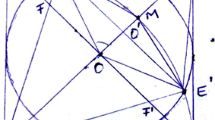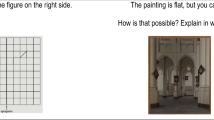Abstract
The present study aims to examine mathematical creativity in students’ work in geometry. Research conducted was based on two aspects: (a) examining the influence of geometrical figure apprehension on the production of multiple solutions and (b) how the necessity to construct auxiliary lines in the given shape promotes the production of multiple solutions and the variables of creativity. Data was collected from 243 tenth graders (15 and 16 years old); all participants were asked to complete a 2-part test, a multiple solution problem solving test, and a geometrical figure apprehension test. The analysis of the results primarily shows that the way through which students perceive the geometrical figure and their ability to process it, is an important factor in predicting their mathematical creativity. Furthermore, it became evident that only perceptual apprehension of geometrical figures is not a reliable predictor of creativity variables, as opposed to operative apprehension of geometrical figures that positively predict the characteristics of creativity: fluency, flexibility, and originality.



Similar content being viewed by others

Change history
28 May 2022
A Correction to this paper has been published: https://doi.org/10.1007/s10763-021-10210-0
References
Battista, M. T. (2007). The development of geometric and spatial thinking. In F. Lester (Ed.), Second Handbook of Research on Mathematics Teaching and Learning (pp. 843–908). Reston, VA: National Council of Teachers of Mathematics.
Brousseau, G. (1997). Theory of didactical situations in mathematics. Dordrecht, The Netherlands: Kluwer.
Brunkalla, K. (2009). How to increase mathematical creativity – An experiment. The Montana Mathematics Enthusiast, 6(1), 257–266.
de Villiers, M. (1998). An alternative approach to proof in dynamic geometry. In R. Lehrer & D. Chazan (Eds.), Designing learning environments for developing understanding of geometry and space (pp. 369–393). Hillsdale, NJ: Lawrence Erlbaum Associates.
Deliyianni, E., Elia, I., Gagatsis, A., Monoyiou, A., & Panaoura, A. (2010). A theoretical model of students’ geometrical figure understanding. Proceedings of the 6th Conference of the European Society for Research in Mathematics Education (CERME 6), Lyon, France.
Duval, R. (1995). Geometrical pictures: Kinds of representation and specific processings. In R. Sutherland & J. Mason (Eds.), Exploiting mental imagery with computers in mathematics education (pp. 142–157). Germany: Springer.
Duval, R. (1999). Representations, vision and visualization: Cognitive functions in mathematical thinking. Basic issues for learning. In F. Hitt & M. Santos (Eds.), Proceedings of the 21st Conference of the North American Chapter of the International Group for the Psychology of Mathematics Education (Vol. 1, pp. 3–26). Mexico: Morelos.
Duval, R. (2014). The first crucial point in geometry learning: Visualization. Mediterranean Journal for Research in Mathematics Education, 13(1–2), 1–28.
Duval, R. (2017). Understanding the mathematical way of thinking – The registers of semiotic representations. London: Springer.
Elia, I., Gagatsis, Α., Deliyianni, Ε., Monoyiou, Α., & Michael, S. (2009a). A structural model of primary school students’ operative apprehension of geometrical figures. Proceedings of the 33rd Conference of the International Group for the Psychology of Mathematics Education (PME), Thessaloniki, Greece.
Elia, I., Van den Heuvel-Panhuizen, M., & Kolovou, A. (2009b). Exploring strategy use and strategy flexibility in non-routine problem solving by primary school high achievers in mathematics. ZDM Mathematics Education, 41, 605–618.
Ervynck, G. (1991). Mathematical creativity. In D. Tall (Ed.), Advanced mathematical thinking (pp. 42–53). Dordrecht, Netherlands: Kluwer.
European Parliament and the Council. (2006). Recommendation of the European Parliament and of the Council of 18 December 2006 on key competences for lifelong learning. Retrieved from http://eur-lex.europa.eu/LexUriServ/LexUriServ.do?uri=OJ:L:2006:394:0010:0018:en:PDF.
Gras, R., Suzuki, E., Guillet, F., & Spagnolo, F. (2008). Statistical implicativeanalysis. Germany: Springer.
Gridos, P., Gagatsis, A., Elia, I. & Deliyianni, E. (2019). Mathematical creativity and geometry: The influence of geometrical figure apprehension on the production of multiple solutions. In U. T. Jankvist, M. van den Heuvel-Panhuizen, & M. Veldhuis (Eds.), Proceedings of the 11th Conference of the European Society for Research in Mathematics Education: Working Group 4 (pp. 789–796). Utrecht, Netherlands: Freudenthal Group & Freudenthal Institute, Utrecht University, Netherlands and ERME.
Haylock, D. W. (1987). A framework for assessing mathematical creativity in school children. Education Studies in Mathematics, 18(1), 59–74.
Herbst, P. (2002). Establishing a custom of proving in American school geometry: Evolution of the two-column proof in the early twentieth century. Educational Studies in Mathematics, 49(3), 283–312.
Hsu, H. (2007). Geometric calculations are more than calculations. In J. H. Woo, H. C. Lew, K. S. Park, & D. Y. Seo (Eds.), Proceedings of the 31st Conference of the International Group for the Psychology of Mathematics Education (Vol. 3, pp. 57–64). Seoul, Korea.
Hsu, H. Y., & Silver, E. A. (2014). Cognitive complexity of mathematics instructional tasks in a Taiwanese classroom: An examination of task sources. Journal for Research in Mathematics Education, 45, 460–496.
Kell, H. J., Lubinski, D., Benbow, C. P., & Steiger, J. H. (2013). Creativity and technical innovation: Spatial ability’s unique role. Psychological Science, 24, 1831–1836.
Kwon, O. N., Park, J. S., & Park, J. H. (2006). Cultivating divergent thinking in mathematics through an open-ended approach. Asia Pasific Education Review, 7(1), 51–61.
Leikin, R. (2009). Exploring mathematical creativity using multiple solution tasks. In R. Leikin, A. Berman, & B. Koichu (Eds.), Creativity in mathematics and the education of gifted students (pp. 129–145). Netherlands: Sense Publisher.
Leikin, R. (2014). Challenging mathematics with multiple solution tasks and mathematical investigations in geometry. In Y. Li, E. Silver, & S. Li (Eds.), Transforming mathematics instruction. Advances in mathematics education (pp. 59–80). Cham, Switzerland: Springer.
Leikin, R., & Pitta-Pantazi, D. (2013). Creativity and mathematics education: The state of the art. ZDM - The International Journal on Mathematics Education, 45, 159–166.
Levav-Waynberg, A., & Leikin, R. (2012). The role of multiple solution tasks in developing knowledge and creativity in geometry. Journal of Mathematics Behavior, 31, 73–90.
Lockhart, P. (2002). A mathematician’s lament. Retrieved from https://www.maa.org/external_archive/devlin/LockhartsLament.pdf.
Mamona-Downs, J. (2008). On development of critical thinking and multiple solution tasks. In R. Leikin, A. Levav-Waynberg, & M. Applebaum (Eds.), Proceedings of the International Research Workshop of the Israel Science Foundation (pp.77–79). Haifa, Israel.
Mann, E. (2006). Creativity: The essence of mathematics. Journal for the Education of the Gifted, 30(2), 236–260.
Michael, S., Gagatsis, A., Elia, I., Deliyianni, E., & Monoyiou, A. (2009). Operative apprehension of geometrical figures of primary and secondary school students. In A. Gagatsis & S. Grozdev (Eds.), Proceedings of the 6th Mediterranean Conference on Mathematics Education (pp. 67–78). Plovdiv, Bulgaria: University of Plovdiv, CMS.
Michael-Chrysanthou, P., & Gagatsis, A. (2015). Ambiguity in the way of looking at a geometrical figure. Revista Latinoamericana de Investigación en Matemática Educativa – Relime, 17(4-I), 165–180.
National Council of Teachers of Mathematics. (2000). Principles and NCTM standards for school mathematics. Reston, VA: NCTM.
Palatnik, A. & Dreyfus, T. (2019). Students’ reasons for introducing auxiliary lines in proving situations. Journal of Mathematical Behavior, 55, (#100679).
Polya, G. (1957). How to solve it. Princeton, NJ: Princeton University Press.
Presmeg, N. (2020). Visualization and learning in mathematics education. In S. Lerman (Ed.), Encyclopedia of mathematics education. Cham: Springer. https://doi.org/10.1007/978-3-030-15789-0_161
Senk, S. L. (1985). How well do students write geometry proofs? Mathematics Teacher, 78, 448–456.
Sheffield, L. (2009). Developing mathematical creativity—Questions may be the answer. In R. Leikin, A. Berman, & B. Koichu (Eds.), Creativity in mathematics and the education of gifted students (pp. 87–100). Rotterdam: Sense Publishers.
Silver, E. A. (1997). Fostering creativity through instruction rich in mathematical problem solving and problem posing. ZDM, 3, 75–80.
Singer, F. M., Voica, C., & Pelczer, I. (2017). Cognitive styles in posing geometry problems: Implications for assessment of mathematical creativity. ZDM Mathematics Education, 49, 37–52.
Stupel, M., & Ben-Chaim, D. (2017). Using multiple solutions to mathematical problems to develop pedagogical and mathematical thinking: A case study in a teacher education program. Investigations in Mathematics Learning, 9(2), 86–108.
Torrance, E. P. (1994). Creativity: Just wanting to know. Pretoria, South Africa: Benedic books.
Acknowledgements
This research is carried out / funded in the context of the project “Multidimensional approach to mathematical creativity as a tool for learning and using geometry with applications in the teachingof fractions, in problem solving and problem posing in the transition from primary to secondary education” (MIS 5050336) under the call for proposals “Supporting researchers with an emphasison new researchers” (EDULLL 103). The project is co-financed by Greece and the European Union (European Social Fund- ESF) by the Operational Programme Human Resources Development, Education and Lifelong Learning 2014-2020.
Author information
Authors and Affiliations
Corresponding author
Additional information
The original version of this article was revised: The original version of this article unfortunately contained incorrect Acknowledgements.
Rights and permissions
About this article
Cite this article
Gridos, P., Avgerinos, E., Mamona-Downs, J. et al. Geometrical Figure Apprehension, Construction of Auxiliary Lines, and Multiple Solutions in Problem Solving: Aspects of Mathematical Creativity in School Geometry. Int J of Sci and Math Educ 20, 619–636 (2022). https://doi.org/10.1007/s10763-021-10155-4
Received:
Accepted:
Published:
Issue Date:
DOI: https://doi.org/10.1007/s10763-021-10155-4



